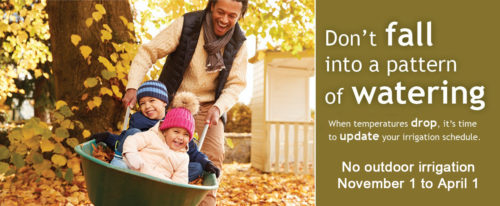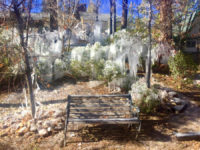
 Big Bear, CA – Every year the City of Big Bear Lake Department of Water has the unfortunate task of informing homeowners they have a burst pipe or broken irrigation system, often the result of freezing temperatures. Winter weather is on its way and if you want to keep your water flowing, be water wise and winterize. The most important step is to use your stop and waste drain valve to drain your pipes anytime you leave for extended periods. Freezing water expands by 9 percent, enough to break plastic, copper and even steel. A one-eighth-inch split can gush 250 gallons a day, ruining tile and carpet, shorting electrical appliances and destroying furniture.
Big Bear, CA – Every year the City of Big Bear Lake Department of Water has the unfortunate task of informing homeowners they have a burst pipe or broken irrigation system, often the result of freezing temperatures. Winter weather is on its way and if you want to keep your water flowing, be water wise and winterize. The most important step is to use your stop and waste drain valve to drain your pipes anytime you leave for extended periods. Freezing water expands by 9 percent, enough to break plastic, copper and even steel. A one-eighth-inch split can gush 250 gallons a day, ruining tile and carpet, shorting electrical appliances and destroying furniture.
Here are some winterization tips you should take:
Outdoors
- Shut off and drain all outdoor irrigation no later than November 1st
- Local regulations require outdoor irrigation winterization November 1 through April 1.
- Local soil temperatures have already dropped to around 50 degrees, the temperature at which lawns go dormant.
- Detach and drain your garden hose
- This prevents freezing water from backing up into the wall behind the spigot.
- Frozen water inside a hose can also damage the hose material.
- Mark your stop and waste drain valve with a tall stake so that you can find it in the snow.
Indoors
- Insulate exposed water pipes including those under sinks, in attics, crawl spaces or outside your house.
- If you can, leave your heat set for 50-55 degrees; this does not replace winterizing your home.
- Consider opening cabinet doors under sinks to let warmer indoor air circulate near the pipes.
Last but not least, “Don’t Let Frosty Down.” Inside the DWP meter box is a white foam pad known as a frost mat, or “Frosty,” that protects your meter from freezing. Like foam on coffee, it should always stay on top. If you’ve had work done and your frosty isn’t on top and level, give it a good tug up.
Complete details on winterization and a printable brochure can be found at BBLDWP.com/Winterize.


